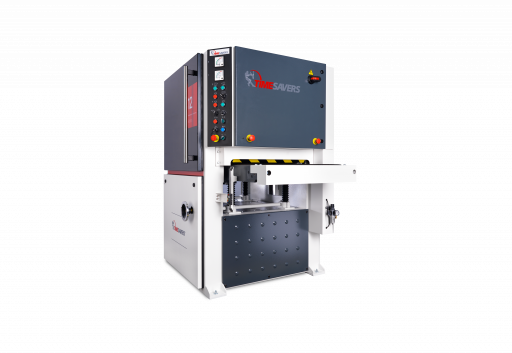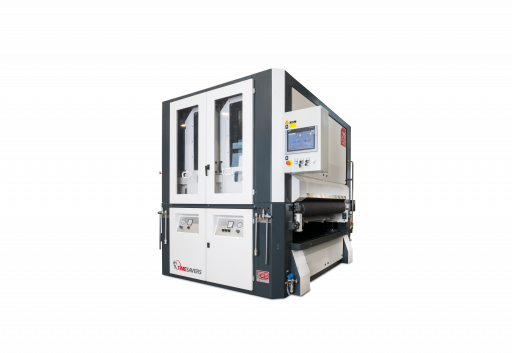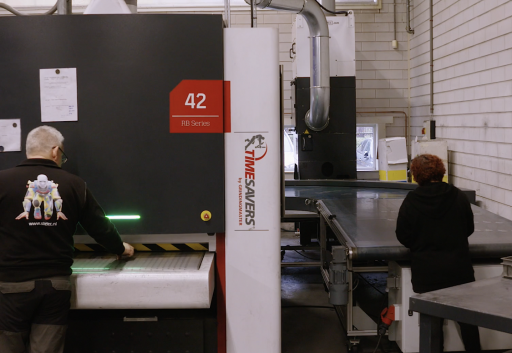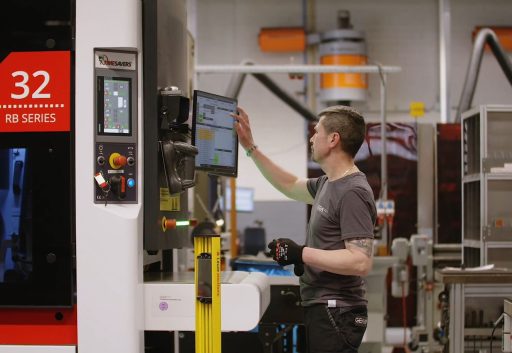Sheet metal finishing is a crucial aspect of the manufacturing process that transforms raw metal sheets into high-quality products with impeccable surface finishes. The process of metal surface finishing involves various techniques and technologies designed to enhance both the appearance and functionality of sheet metal components of various types of metals.
Your problem, our solution
The perfect finish with a Timesavers
Timesavers offers machines for every type of finish. From the Manual Grinder to the rotary brush machines, to the 81 series; all Timesavers machines have their unique finish capabilities. The finishes can be applied to a variety of materials depending on the machine.
The Significance of Metal Surface Finishing
Metal finishing is the final step in the production of sheet metal components, and its importance cannot be overstated. It serves multiple purposes, making it an integral part of various industries:
Aesthetics: Metal surface finishing greatly improves the visual appeal of sheet metal products. Whether it’s steel, stainless steel, aluminum, or copper, the right finish can give sheet metal components a polished and professional look. This is crucial in industries where aesthetics matter, such as architecture and interior design.
Corrosion Resistance: Metal finishing treatments create a protective barrier on the surface, reducing susceptibility to corrosion. In particular, stainless steel metal finishes are highly resistant to rust and staining, making them ideal for outdoor applications and marine environments.
Durability: Sheet metal finishing can significantly increase the durability and longevity of products. It helps to mitigate wear and tear, ensuring that sheet metal components stand the test of time, even in harsh conditions.
Precision: Metal surface finishing can achieve the tight tolerances and precise dimensions required in industries like aerospace and automotive. This precision ensures that metal parts fit together seamlessly, contributing to the overall functionality of the end product.
All you need to know about surface roughness (Ra)
All you need to know about surface roughness (Ra)
When working in metal finishing industries, you have most certainly heard about surface roughness. It measures the irregularities on metal surfaces. Now what measurements are there? And why is it important?
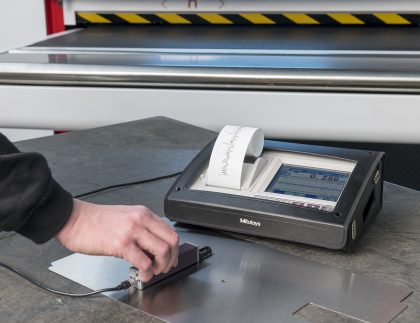
Methods of Finishing metal
Sheet metal finishing encompasses a wide range of methods and techniques, each tailored to achieve specific results. Let’s explore some of the most common methods:
Grinding and Polishing: Flat metal finishing often involves grinding to remove surface imperfections and polishing to achieve a smooth, mirror finish. This method is particularly effective for stainless steel metal finishes.
Brushing: Brushed finishes create a distinctive pattern of fine parallel lines on the metal’s surface. It is commonly used for decorative applications, such as appliance panels and architectural elements.
Anodizing: Anodizing is a process that forms a protective oxide layer on the surface of aluminum. It enhances corrosion resistance, improves durability, and can be dyed to create various colors.
Plating: Electroplating is a form of metal fabricating used to apply a thin layer of metal, such as chrome or nickel, to the surface of sheet metal components. This not only enhances the appearance but also provides additional protection against corrosion.
Powder Coating: Powder coating involves applying a dry powder to the surface of the metal plating and then curing it with heat. This method is known for its durability, corrosion resistance, and the ability to achieve a wide range of colors and textures.
Chemical Treatments: Chemical treatments like passivation and pickling are used to remove contaminants and oxide layers from the surface of stainless steel, improving its corrosion resistance.
Shot Peening: Shot peening involves bombarding the surface of the metal or sheet metal parts with tiny spherical media to induce compressive stresses. This process enhances the material’s resistance to fatigue and stress corrosion cracking.
The Role of Sheet Metal Finishing in Different Industries
Sheet metal finishing plays a pivotal role in various industries, each with its unique requirements and challenges:
Automotive Industry: In automotive manufacturing, sheet metal components must meet stringent quality and aesthetic standards. Metal surface finishing ensures that car bodies, trim, and other parts have a flawless appearance while providing corrosion resistance for longevity.
Aerospace Industry: The aerospace sector demands precision and reliability. Sheet metal finishing is crucial to ensure that aircraft components have the necessary surface finish quality, precision, and corrosion resistance to withstand the rigors of flight.
Architectural and Construction: In architectural applications, sheet metal finishing is used to create stunning facades, railings, and decorative elements. It also provides durability and corrosion resistance, vital for structures exposed to the elements.
Electronics and Appliances: Metal finishing is essential for consumer electronics and appliances to maintain polished finishes and clean appearance. It also serves as a protective layer against corrosion, ensuring the longevity of these products.
Medical Devices: Medical equipment and devices require impeccable surface finish to ensure hygiene and ease of cleaning. Stainless steel metal finishes are often used for their corrosion resistance and biocompatibility.
What is the right solution for you?
By answering 5 simple questions, we lead you to the right machine for your application.
Metal finishing with Timesavers machinery
Precision Grinding: We employ advanced grinding techniques to achieve flat metal finishing and precise surface quality.
Deburring and Edge Rounding: Our machinery can efficiently remove burrs and sharp edges, enhancing the safety and aesthetics of your sheet metal components.
Wide Belt Sanding: We use wide belt sanding technology for consistent surface finishing, ensuring that your sheet metal products meet the highest standards.
Custom Solutions: Timesavers International can tailor our sheet metal finishing processes to meet your specific requirements, whether it’s for aesthetics, corrosion resistance, or precision.
Timesavers tooling
Timesavers tooling
Different types of metal and applications require different tools to process. Timesavers has partnered up with 3M and Boeck to provide the highest quality tools to create the perfect surface finish sheet metal on all types of metal.

Timesavers International: Your Partner in Metal finishing
Timesavers International is a leader in the sheet metal finishing industry, offering a wide range of solutions to meet the diverse needs of our customers. Our state-of-the-art machinery and expertise in metal finishing ensure that we can provide superior results in terms of metal surface finish, flat metal finishing, and sheet metal finish quality.
FAQ about finishing
+
Why apply a finish on metal?
A finish on metal parts is aesthetically pleasing and can reduce the surface roughness. A smooth surface is hygienic and can be a requirement for products that are intended for the food industry and pharmacy.
+
What finish should I apply?
Depending on the purpose of the product, a decision can be made for a (non-)directional finish that can go from dull to shiny to even highly mirrored.
+
What finishing technique can be used for metal parts, metal plates or coils?
A finish applied with non-woven material or rotary brushes is often used for metal parts that only need a finish for aesthetic reasons. Metal plates and coils however, require often a low surface roughness (Ra) that can be obtained by using multiple abrasive belts.
+
What types of metal finishes are there?
Number 0 Finish
the starting finish of hot rolled, tempered sheets.
Number 1 Finish
This is a dull and slightly rough surface, which is the starting finish on sheets of a hot rolled, tempered, etched and passivated process.
Number 2D Finish
This dull finish is superior to a No. 1 finish and is the starting finish on sheets of a cold rolled, tempered, etched and passivated process.
Number BD Finish
This is a glossy finish on sheets, due to a cold rolled, polished, tempered, etched and passivated process.
Number 2BA Finish
This is a mirror-like finish with some imperfections. BA stands for Bright Annealed, which is made in a controlled atmosphere.
Number 3 or 4 Finish
These finishes can be obtained with abrasive belts ranging from grit 120 or 180 to even 240 or 320. No. 3 is great for food processing equipment, while No. 4 is a little brighter and finer, often used for escalators, elevators and architectural buildings for example.
Number 5 Finish
A finish applied with non-woven abrasive.
Number 6 or 7 Finish
A finish of which the surface is processed with grinding compounds. With no. 7 there are additional cotton mops, which are polish compounds.
Number 8 Finish
A true mirror finish, produced on sheets with the use of discs. This process uses a mixture of abrasive compound and water to do the polishing.
Non-directional Finish
Products with this type of finish can be put in every possible direction.
Hairline Finish
This finish has a long, continuous straight lines parallel to the length of the sheet metal.
Duplo Finish
A duplo finish is a finish with combination of first abrasive belt and then Scotch-Brite brush.
Microlon Finish
Is a finish applied with Scotch-Brite brushes or even Scotch-Brite belts.
Powder coating Finish
This finish makes parts that are made during CNC machining processes resistant to corrosion and aesthetically pleasing. Although it is not recommended for smaller components and internal surfaces, it is suitable for military applications or industrial equipment.
Sandblasting Finish
This finish removes the top-layer of a part by highly pressurized sand, thus creating a uniform and smoother surface texture.


